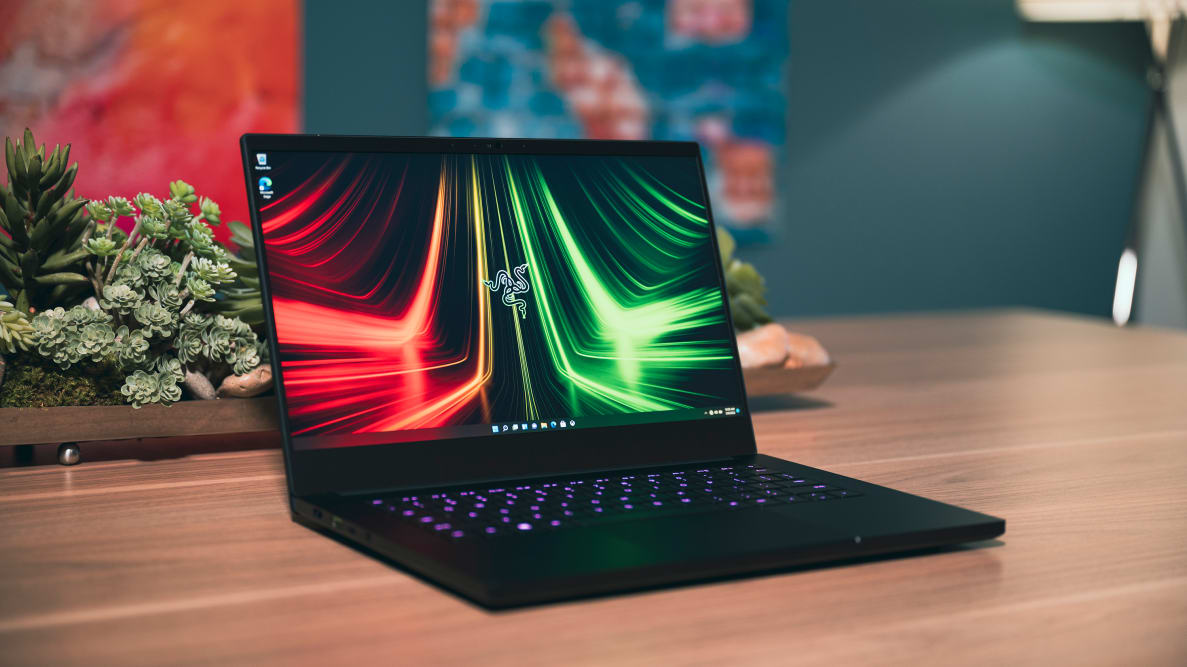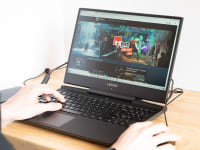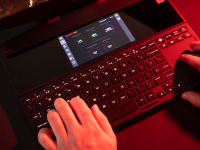Pros
-
Superb battery life
-
Mechanical-like keyboard
-
Vibrant display
Cons
-
Poor quality speakers
-
Trackpad quirks
-
It can run hot
Configured with one of AMD’s latest mobile chips and an Nvidia graphics card, this generation’s Blade 14 is not much faster than the 2021 model, but Razer noticeably increased the display brightness and increased battery life by about an hour. However, the “MacBook of gaming” still retails for MacBook-level prices, leaving Razer to compete with other gaming companies that sell equally powerful laptops for hundreds of dollars less.
About the Razer Blade 14 (2022)
-
Processor: AMD Ryzen 6900HX
- Memory: 16GB DDR5 4800 MHz (Fixed on-board)
- Storage: 1TB SSD (M.2 NVMe PCIe 4.0)
-
Display: 14-inch QHD (2560 x 1440) 16:9, 165Hz, IPS panel, FreeSync Premium,
-
Ports: 2 x USB 3.2 Gen 2 Type-A, 2 x USB 3.2 Gen 2 Type-C with Power Delivery and Display Port 1.4 (charging supported with 20 V USB-C chargers with PD 3.0), HDMI 2.1, 3.5 mm headphone/microphone jack
- Graphics: Nvidia RTX 3070 Ti (discrete), AMD Radeon 6 80M (integrated)
-
Wireless: Qualcomm WCN6856 Wi-Fi 6E, IEEE 802.11a/b/g/n/ac/ax, Bluetooth 5.3
- Battery: 61.6 Whr
- Dimensions: 12.59 x 8.66 x 0.66 inches
- Weight: 3.92 pounds
- Warranty: 2-years limited
The 2022 Blade 14 comes in three slightly different configurations. Every model has a Ryzen 9 6900HX processor, but you can choose from an RTX 3060, an RTX 3070 Ti, or an RTX 3080 Ti graphics card. The model with the slowest card, the RTX 3060, comes with a 144 Hz display instead of the 165 Hz version on the 3070 Ti and 3080 Ti configurations. Our review unit retails at $2,600 while the RTX 3060 version retails for $2,000 and the RTX 3080 Ti version for $3,500.
What we like
Surpurb battery life
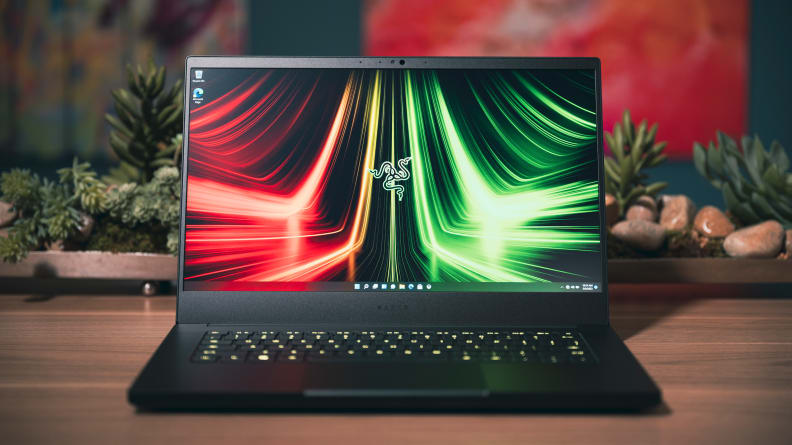
Razer's Blade 14 is yet another addition to the "gaming laptops with a long battery life" list.
When we measured battery life on last year’s Blade 14, we were surprised it lasted seven hours. Granted, that’s seven hours of casual web browsing, not gaming, but that’s still a long time for a gaming laptop. So, it’s impressive that Razer was able to extend its Blade 14 battery life by another hour—even with the same-sized battery as last year’s model. Part of that has to do with how power-efficient AMD’s Ryzen 9 6900HX is compared to its older sibling, the Ryzen 9 5900HX, which AMD achieved with a few small architectural and software changes.
We measured the total power draw with a Kill A Watt meter while running the Metro Exodus benchmark at 1080p with the Ultra graphics setting turned on and ray tracing set to high. The Blade 14 drew up to 176 watts when the system was in Performance mode. 54W were consumed by the CPU only, according to HWInfo64. Both the Ryzen 9 6900HX and Ryzen 9 5900HX have a default power draw of 45W, but it’s clear AMD’s newer 6000-series CPUs are the more power-efficient chips even though they have the same power draw.
The Ryzen 9 6900HX’s power draw is not too far off from Apple’s MacBook Pro 13 M1. Where the MacBook consumed about 51W during our usual Cinebench multi-core test, the Blade 14 consumed about 69W. This isn’t surprising because Apple’s chip architecture includes dedicated efficiency cores, but considering AMD’s history with making power-hungry components, getting within about 15W of the M1 is darn good.
A non-mechanical keyboard that feels mechanical
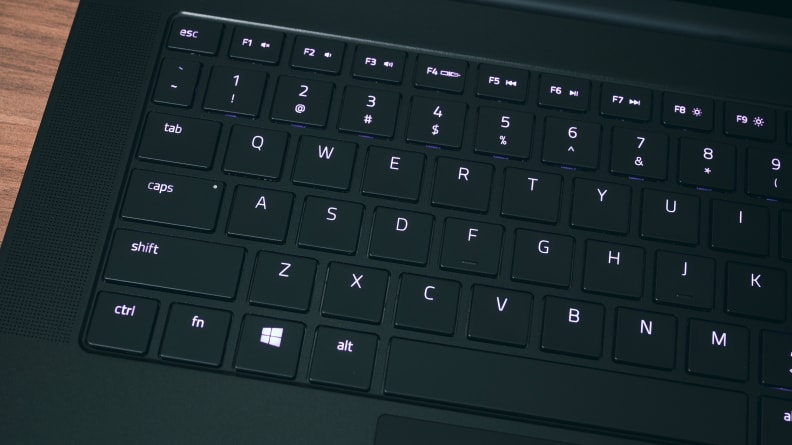
For a membrane keyboard, the keys on the Blade 14 are surprisingly snappy and super quiet.
Traditional membrane keyboards use rubber domes that trigger small electrical contacts when they are pushed down. Each key does not have an individual switch like mechanical keyboards, so typing usually feels soft or mushy, but the keys are much quieter. Yet Razer has combined the best of both worlds to create a keyboard for the Blade 14 that’s as quiet as the MacBook Pro’s scissor switches yet feels as responsive as Razer’s mechanical gaming keyboards.
The actuation point is shallow for my taste (there’s a very short travel distance between when a key is first pressed and when the input registers on-screen), but typing did feel like each key had its own linear mechanical switch, like Cherry Reds or Razer’s Yellow switches. This made gaming, writing emails, revising chapters in my novel, and every typing-related task you can think of extremely pleasant, even when I was furiously tying away in a quiet café (and I’m a heavy-handed typist, too).
Vibrant display
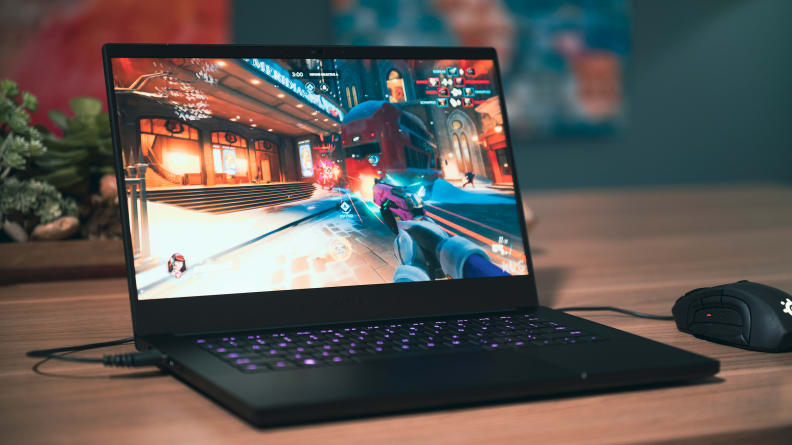
The Blade 14 has one of the best displays on a gaming laptop.
Razer claims the Blade 14 has an individually factory-calibrated IPS display with up to 100% of the DCI-P3 color gamut, which is a technical way of saying the display has more color depth than this Popsicle commercial from the 90s. Okay, so the Blade 14 has way more colors than that retro Popsicle commercial, but we used a colorimeter with a display calibration software called DisplayCal to figure out just how many.
Unfortunately, you’re most likely to only see 72.6% of the DCI-P3 color gamut according to our tests, which is an important measurement for anyone who does highly precise colorwork. That might not cut it for some creative professionals, but the display covers 99.1% of the sRGB color gamut, which is a more common standard measurement of color that covers most creative needs. Combined with the display's 1440p resolution and a max brightness of 360 nits, everything from games to movies will still look gorgeous on the Blade 14’s display.
Ray traced games look especially gorgeous. Cyberpunk 2077, for instance, looks better on this laptop’s display than my Asus ROG Swift PG27UQ 4K monitor. Shaded regions follow a smooth and seamless gradient into pitch black. The lights of Night City cascade into a brilliant combination of colors, from neon and earth tones to the light reflecting off the polished marble flooring inside Konpeki Plaza. It’s like loading an image into photoshop and already having the exposure, brightness, and contrast perfectly set.
Good gaming performance
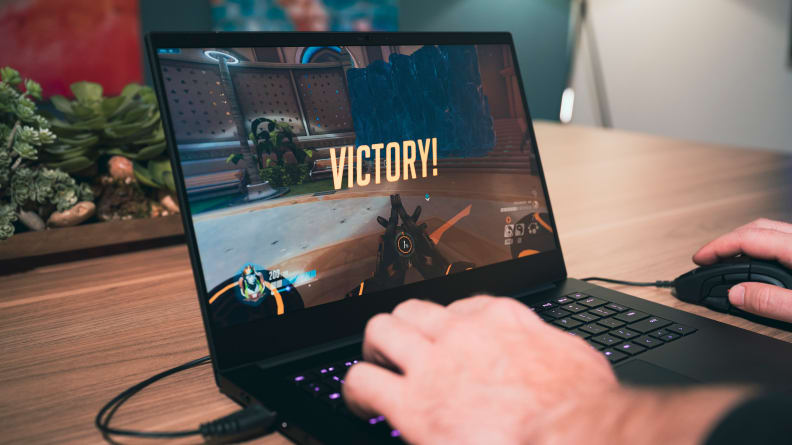
The Blade 14's 165Hz screen combined with its RTX 3070 Ti ensures you'll get high frame rates in esports games.
Like its predecessor, the new Blade 14 doesn’t break benchmarking records, but you can count on it to pump out high frame rates, especially in esports games. Compared to the Asus ROG Strix G15 with an equivalent AMD Radeon RX 6800M graphics card, the Blade 14 generates 60-65 more frames per second (fps) in Overwatch at 1080p with graphics preset set to Ultra (219 fps to 159 fps, respectively). Compared to the Lenovo Legion 5 Pro Gen 6 with an RTX 3070 graphics card (which is one step below the RTX 3070 Ti in the Blade 14), the gap is smaller but still pronounced at 219 fps to 186 fps, respectively.
In more demanding games like Far Cry 5, Shadow of the Tomb Raider, Cyberpunk 2077 and Total War: Warhammer II, the Blade 14 still had a decent lead over some of its competitors, about an average of 10-20 fps. The Blade 14 was virtually even with the much cheaper Lenovo Legion 5 Pro Gen 6 in Cyberpunk 2077, 74 to 72 fps, respectively.
However, when we ran the same Cyberpunk benchmark with ray tracing turned on, the Blade 14 struggled to keep up with the Lenovo Legion 5 Pro Gen 6 (33 fps to 56 fps, respectively). This is surprising because the Blade 14 has the faster of the two graphics cards, as well as a faster processor, but when you dig a little deeper it makes sense; The Blade 14’s RTX 3070 Ti power draw is capped at 100W, so it’s not getting enough juice to adequately process ray-traced graphics. Still, it's solid performance that should keep most gamers more than satisfied.
What we don’t like
Audio is still lackluster
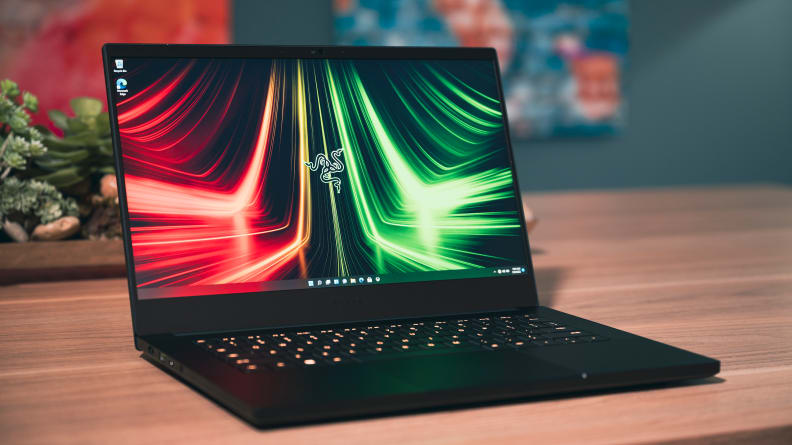
To get the best performance out of Razer's Blade 14, turn on the performance setting with the included Razer Synapse software.
For all the careful attention to detail, Razer gives to every single aspect of its laptops, the sound quality on the Blade 14 is still not great. We didn’t like it on last year’s model, and we don’t like it this time around. It’s not the worst we’ve ever heard on a laptop, but for a laptop that costs $2,600 the audio should sound much better.
Even with some audio tuning, the bass is nearly non-existent in heart-pumping, classic goth club anthems like Sisters of Mercy’s Temple of Love and explosion-rich game environments like the streets of Cyberpunk 2077’s Night City. Dialogue comes through clearly thanks to the focus on the treble, but if you want to take advantage of the Blade 14’s THX Spatial audio, you will need headphones that support it. Any decent gaming headset should sound better than the Blade 14’s speakers, and this is the case with every laptop we’ve tried.
The trackpad could be more precise
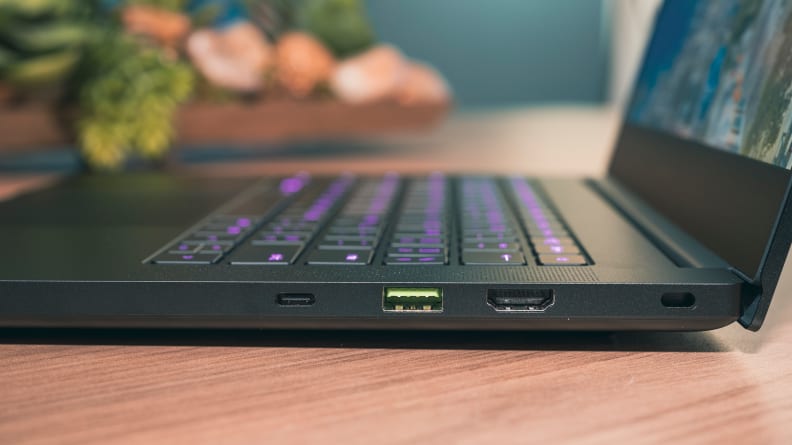
Unfortunately, the Blade 14's GPU power draw is limited to 100W, so ray tracing performance is lower than you would normally expect.
In some ways, the Blade 14’s trackpad rivals that of Apple’s MacBook Pro 13, which has arguably the best laptop trackpad available. Razer has Apple nearly beat with a glass trackpad that’s ever so slightly smoother and registers taps and presses with more consistency than my MacBook Pro 13. But when it comes to two-finger page scrolling, I refuse to use the Blade 14’s trackpad.
The neat thing about the MacBook trackpad and other Windows machines’ trackpads is that you don’t need to move those two fingers in a perfectly straight line to scroll up or down on a page. Normally, you swipe your fingers up or down in an arch across a trackpad and the laptop will understand what you are trying to do. But for some reason, you must move your fingers in a straight up and down motion on the Blade 14’s trackpad instead.
This meant every time I wanted to scroll through a webpage (which was often) I had to turn my elbow outward to get my wrist in the correct position. This was not comfortable nor sustainable over even a short period of time, so I used a stand-alone mouse nearly the entire time.
It can run hot
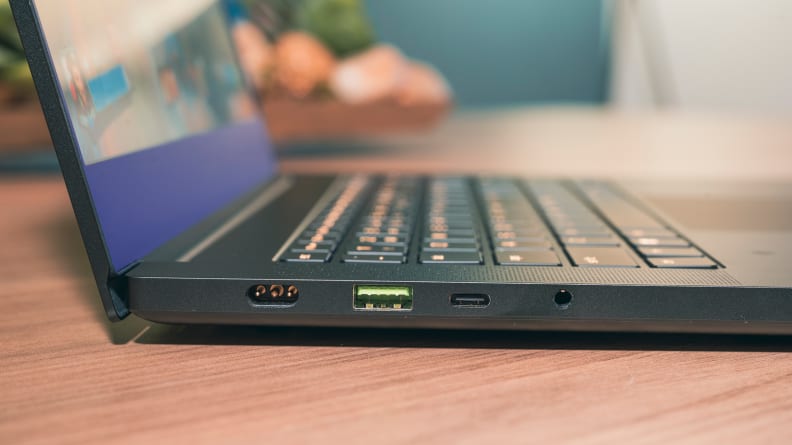
The Blade 14 doesn't have a ton of ports, but it has enough for essential peripherals.
Razer cleverly placed the most important hardware components under the right side of the keyboard to get them out of the way of the WASD movement keys. Your left fingertips will be grateful to escape the heat that permeates through the aluminum chassis—that spot on the Blade 14 reaches 50 degrees Celsius (122 Fahrenheit), which will sting your fingers a bit. Thankfully, this only happens while gaming. When performing simple tasks, the chassis remains at a cool 35C (95F).
However, all that heat mostly comes from the processor, which we saw top out at 98C (208F). That temperature is three degrees above AMD’s listed max operating temperature, 95C (203F), but HWInfo64 did not report thermal throttling—when the processing speed slows down because the CPU gets too hot. In fact, we saw several cores reach a max frequency of 4.8GHz, nearly the max clock speed AMD lists on its website. The Ryzen 9 6900HX may be fast and more power-efficient, but it can easily reach its thermal limits, and CPUs that reach their thermal limits produce a lot of heat.
Should you buy it?
Maybe, if you really like Razer
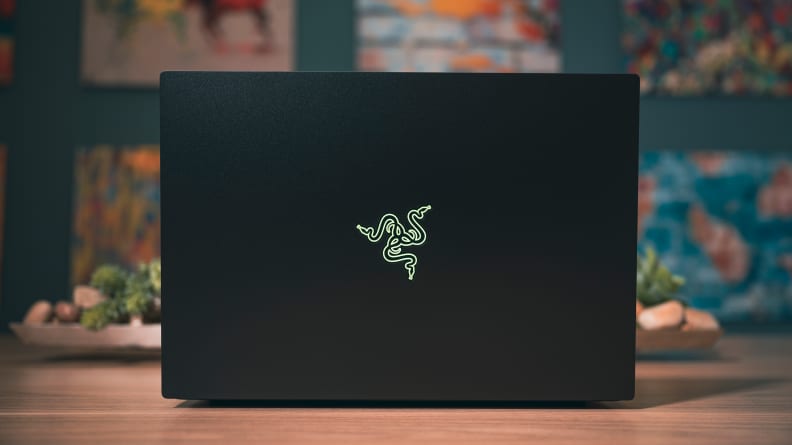
The Razer Blade 14 can be summed up like this: If you're drawn to its classy looks more than its performance, then this laptop is for you. I just hope you like spending money.
Razer has the science of packing tons of power into a tiny chassis down to an art. Companies like Asus, MSI, Acer, Lenovo, and others have recently swapped the traditionally bulky gamer aesthetic for designs that fit better into a work environment. (Acer’s Triton SE 300 is a great example.) But all those companies usually sacrifice something to keep the price as low as possible, whether that’s keyboard quality, battery life, or a dim and color-muted display. The Razer Blade 14 not only has the look but it also has premium extras like a fantastic keyboard and great battery life to back it up. But you’ll pay a pretty penny to get them.
If spending $2,600 on a gaming laptop is too rich for your blood, and you’re not particularly fond of Razer’s aesthetic, there are a plethora of options that will net you powerful gaming performance for hundreds of dollars less. The Asus ROG Strix G15 with a last-gen Ryzen 9 5900HX nets similar performance to the Blade 14, as does the Lenovo Legion 5 Pro Gen 6, MSI Delta 15, and many others. Like last-gen’s Blade 14, the performance of the newest one is “great, but not gonzo," because Razer has capped the graphics card's power draw. This doesn't affect performance if ray tracing is turned off, but it does when the special lighting feature is turned on.
Even with diminished ray tracing performance, Razer’s Blade 14 is still worth considering, especially for those with deep pockets. The Blade 14’s incredible 1440p display is just one reason of many to throw down the extra cash on something that not only makes colors pop and blacks super inky but will also hold up over time.
The product experts at Reviewed have all your shopping needs covered. Follow Reviewed on Facebook, Twitter, Instagram, TikTok, or Flipboard for the latest deals, product reviews, and more.
Prices were accurate at the time this article was published but may change over time.
Meet the tester
Joanna specializes in anything and everything gaming-related and loves nerding out over graphics cards, processors, and chip architecture. Previously she was a staff writer for Gizmodo, PC Gamer, and Maximum PC.
Checking our work.
Our team is here to help you buy the best stuff and love what you own. Our writers, editors, and experts obsess over the products we cover to make sure you're confident and satisfied. Have a different opinion about something we recommend? Email us and we'll compare notes.
Shoot us an email